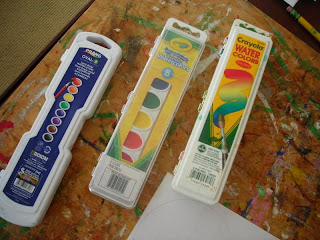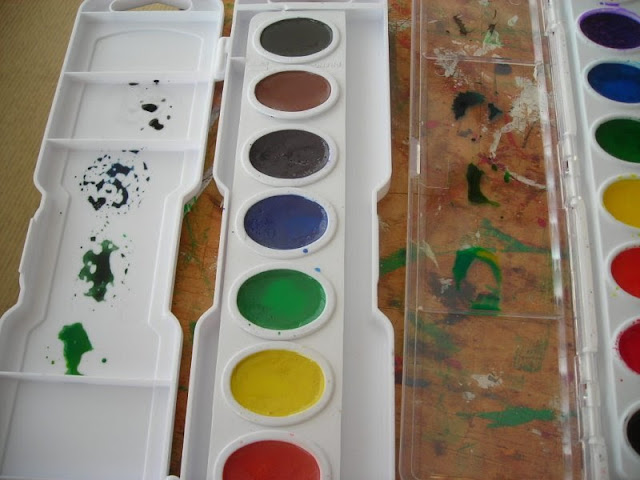Then, of course, I started fooling around with some projects using some of these ideas.
First, I thought about having students divide their paper in fourths (using a ruler, and measuring). I met with some local art teachers not too long ago, and we were all bemoaning how many kids manage to get to 4th grade without having mastered this skill!!
After making some more divisions, I used cake tempera to mix colors in each section, showing a variety of the color theories on the chart (warm/cool, monochromatic, etc.)tertiary, etc)
Then I started thinking about that box of art materials that Dixon/Prang sent me to review and got out their Prang watercolor pan, the Crayola Washable set that they sent me and my own regular Crayola pan (not washable).
I started by discarding the brush from the Crayola Washable set. It is one of those plastic brushes with bristles that are cut straight across at the tip - no way you are EVER going to get a point with that brush. Then I compared the Prang brush from this new set to the brush I have been using for awhile from an older Prang Pan Watercolor set. The older brush is on top and appeared to form a better point when put in water. But, I gave the new brush a try. After about 5 minutes I switched back to my older Prang brush because I got tired of picking hairs up from my painting!! This won't be an issue in the classroom, though, because we use different brushes altogether.
First I made some circles and tried painting various stripes. Most of what I ask students to do with watercolor is not this controlled. We are more apt to use them for washes and wet-on-wet work. But, I was mostly testing color intensity here. Prang is on the left and Crayola Washable on the right. At the bottom I did a quick color comparison adding my old Crayola (non-washable variety) pan watercolor. I have never used washable watercolors before, so I didn't know what to expect. Although it doesn't show too well in these photos, the washable blue was almost an aqua and purple was more of a magenta. I also had to stir and stir and stir (you get the idea) the brush in washable paints to get any color on the brush. The Prang Semi-Moist and the regular Crayola paints were very similar in intensity although the hues were not an exact match.
Then I decided to do a bit of color mixing to see what would happen. These both created OK results, just a bit different in the hues that I got.
Aside from the intensity of color, I actually have another HUGE criteria when I am choosing pan watercolors. I NEVER buy pans that don't have white lids. It is just too hard to see the color you are trying to mix in a clear lid. And, if it is hard for me, then I figure it is going to be almost impossible for children. You can see what I mean below.
So, what do I order for the classroom? Well, I actually have been using the Prang Semi-Moist for the last few years, although I do have some regular Crayola pans, too. When I order refill ovals, however, I buy some colors from Prang and some from Crayola (as the refills fit both trays), as I prefer certain colors from each. For example, the Prang red is deeper and has a bit more blue in it.
Of course, I had to figure out a way to use all this as a possible school project, so I glued one of the watercolor circles onto my tempera background lining up some of the colored stripes to make some interesting new shapes. I am hoping that a project such as this will generate some good art vocabulary as the kids work on it!!












great color theory lesson, might just steal that to use as a review with my 8th graders!
ReplyDeletethanks for letting me know that the Prang oval refills fit in the crayola pan---because i can't find crayola brand for the magenta color; therefore I need to buy Prang for magenta.
ReplyDelete